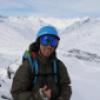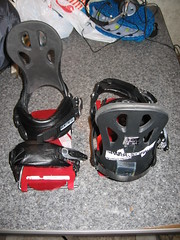Cold Fuse'n with Spark R&D
Last spring, while I was "living" on Thompson Pass in Alaska, I got the opportunity to test out some Spark R&D Fuse bindings with my split board. Erik Morrison, Spark R&D Rep. and King of the Hill Competitor, was gracious enough to let me use them for a couple days, so I got to test drive them on both sled accessed and skin accessed terrain. Although I didn't get to log any heli time with them, I still thought I'd share the experience and my thoughts on the bindings.
- Location: Thompson Pass, Alaska, USA
- Snow Conditions: Epic!! There's no other word really to describe the AK backcountry. Snow conditions varied from fresh, thigh-waiste deep on some days, and wind blown on others.
- Rider: Marc
- Height: 5' 10"
- Weight: 135 lbs
- Boot Size: 9.5 (US)
- Setup:
- 2009/2010 Prior AMF Split with rocker, 156
- 2009/2010 Spark R&D Fuse 2 baseplates (M) with Bent Metal straps and high-back: 18 degrees front, -12 degrees back, 25 inches wide.
- 2000/2010 Burton Ion Boots
First Impression
When riding my split board, I had become used to the weight of my Ride Betas with the requisite Voile plates. So I was surprised at how light the Fuse 2 bindings felt. I was also intrigued by the cube used to adjust the forward lean on the Bent Metal high-backs (patent pending as I understand).
Construction
The Fuse 2 baseplates are machined aluminuim making them durable and very light weight. This also means that the rails required to attach the bindings to the Voilé pucks can be machined right on the bottom of the baseplate – therefore no additional hardware is required – reducing riding and touring height by as much as one half.
Spark R&D manufactures all of their bindings right in Bozeman Montana which is pretty close to the most common backcountry spots in North America. So your bindings shouldn't have to travel very far to reach you.
Tech
- Revolutionary Cube: World's fastest forward lean adjustment. Also uses dual durometer urethane for vibration absorption
- Machined Baseplates: CNC Machined from a solid piece of aluminum means they are strong and lightweight
- Lightweight: The Fuse bindings weight 980g (1960g/pair). For comparison, Burton C60 (2005) weigh 2118g/pair.
Cost: No longer available. Replaced by the Blaze bindings which are essentially the same, but lighter, and cost approximately $299 USD for plates and bindings.
Overall
Riding the Spark R&D Fuse 2 bindings makes the whole splitboarding experience that much better. I can never go back to the old plate system ever again. When I finally had to return the bindings to Erik, I actually asked him if I could keep them; he said no. Fortunately I found a pair of Fuse 2 baseplates in my size a few months later and some Bent Metal bindings on eBay to complete the kit.
I should point out that the Fuse 2 bindings are no longer available as they have been replaced by the Blaze binding; basically the same thing but lighter (1596g/pair). However, they no longer use Bent Metal high-backs and straps (probably due to the fact that Mervin doesn't make Bent Metal bindings anymore), so that also means no more revolutionary cube. Erik did mention that it may still be possible to obtain the Revolutionary Cube from Mervin, but I can't confirm that at this time.
Cube or no cube, I strongly recommend these bindings (or the new Blaze binding) to anyone who's into riding up the mountain as well as riding down. Even though they are hard to come by in the East, I'm sure it won't be long before I see more of them on future excursions to Mount Washington; they are worth the extra effort required to obtain them.




